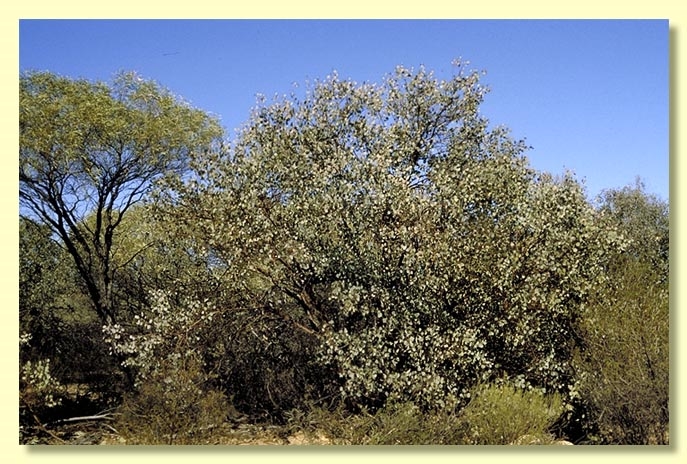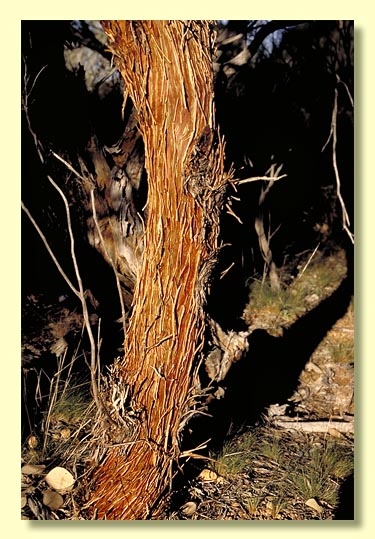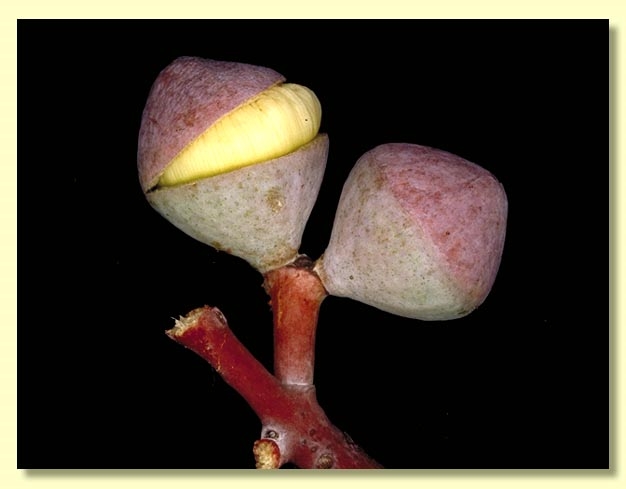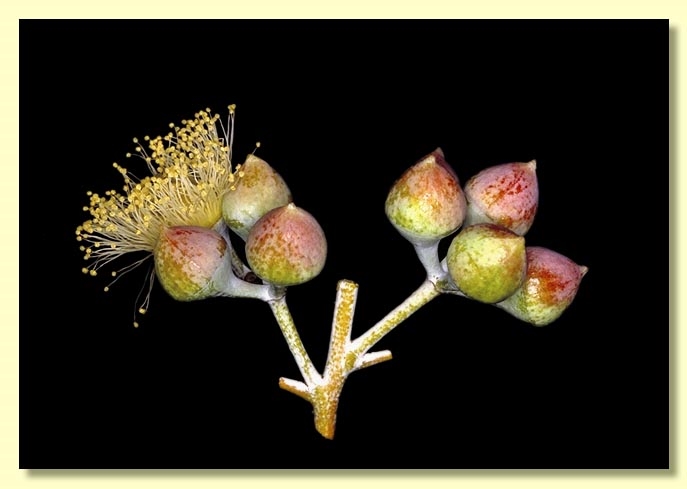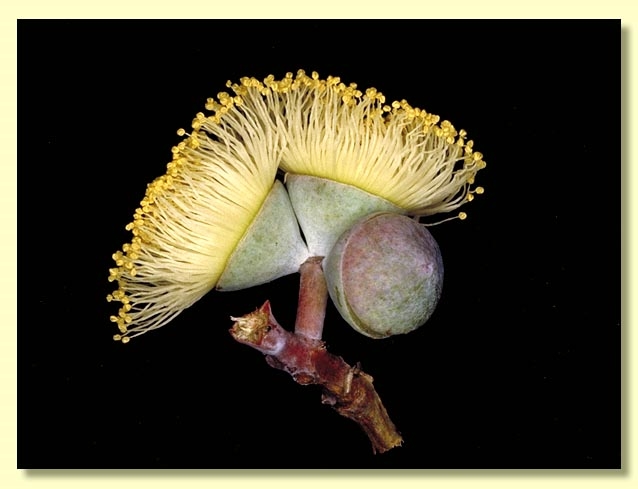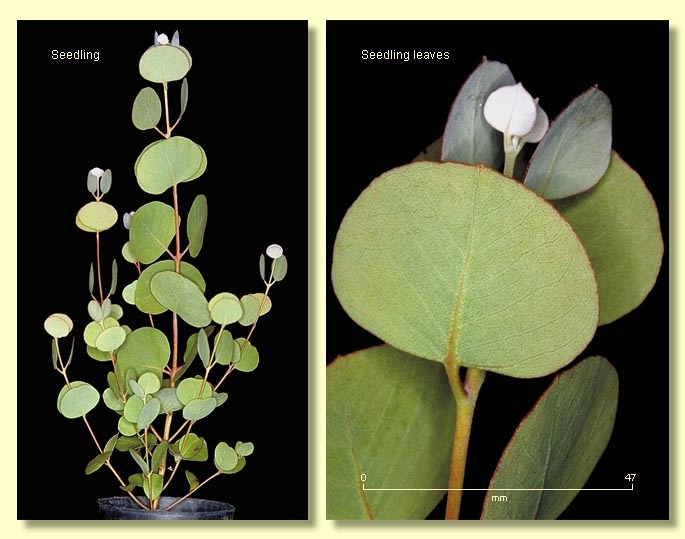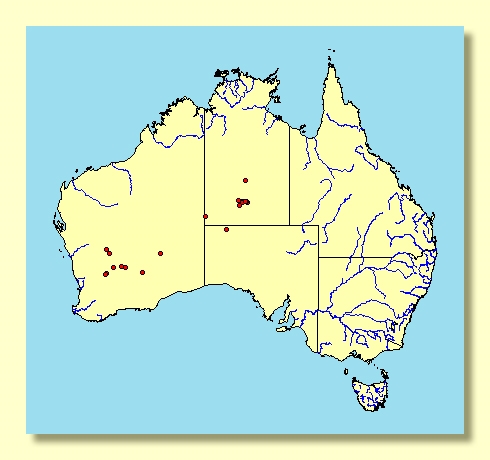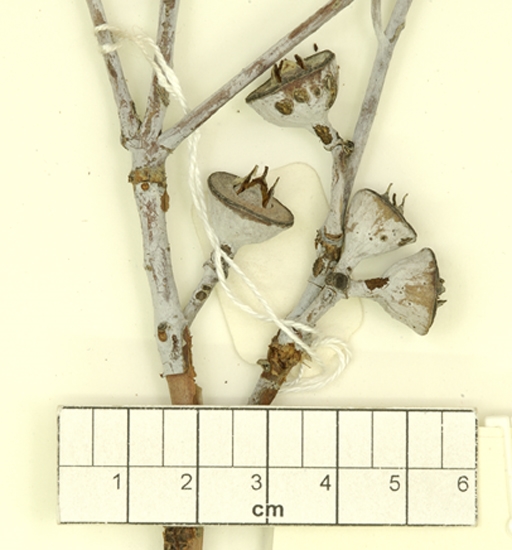Euclid - Online edition
Eucalyptus orbifolia
Eucalyptus | Symphyomyrtus | Bisectae | Destitutae | Curviptera | Orbifoliae
T: 30°47'S, 119°25'E, [NW of Koolyanobbing Ra.], W.A., C.Harper s.n.; holo: MEL; iso: K.
Eucalyptus lata L.A.S.Johnson & K.D.Hill, Telopea 4: 630 (1992). T: Western Australia, 13.6 km W of Callion on Mussons Soak road, 28 Nov 1986, K.D.Hill 2658 & L.A.S.Johnson; holo: NSW; iso: CANB, MEL, PERTH.
Spreading mallee to 5 m tall with canopy often reaching to ground level. Forming a lignotuber.
Bark of large stems sometimes rough, grey, thick and flaky at the base, otherwise minnirichi on trunk and branches, reddish brown.
Branchlets strongly glaucous; lacking oil glands in the pith.
Juvenile growth (coppice or field seedlings to 50 cm): not seen.
Adult leaves sub-opposite to alternate, petiole 0.8–2.4 cm long; blade broadly elliptical to obovate or obcordate, 2.5–5 cm long, 1.3–5 cm wide, base tapering to petiole, apex rounded to emarginate or apiculate, concolorous, dull, greyish green to green, sometimes white with wax, side-veins greater than 45° to midrib, very densely reticulate, intramarginal vein remote from margin, oil glands mostly intersectional.
Inflorescence axillary unbranched, peduncle glaucous 0.5–2 cm long, buds 3 or 7, pedicellate, pedicels 0.3–0.8 cm long. Mature buds globular to slightly ovoid (0.8–1.3 cm long, 0.6–1.2 cm wide), glaucous, scar present, operculum usually rounded, sometimes apiculate, or broadly conical, rarely beaked (0.3–1 cm long), stamens oblique, anthers oblong, versatile, dorsifixed, dehiscing by lateral slits, style long or only ever slightly bent apically, stigma blunt or tapered, locules usually 4 or 5 (rarely 3 or 6), the placentae each with 4 vertical rows of ovules. Flowers yellow.
Fruit pedicellate, pedicels 0.1–0.8 cm long, shallowly and broadly obconical, 0.3–1 cm long, (0.6)0.8–1.5 cm wide, usually glaucous, disc usually level or sometimes raised, valves (3)4 or 5(6), strongly exserted.
Seeds pale brown, 1–1.7 cm long, flattened-ovoid to cuboid with rounded corners, dorsal surface shallowly reticulate, hilum obscurely terminal.
Cultivated seedlings (measured at node 10): cotyledons Y-shaped (bisected); stem rounded in cross-section, warty; leaves always petiolate, opposite for at least 13 nodes, orbicular (usually wider than long), 2.5–5 cm long, 3–6.5 cm wide, apex entire or emarginate, green or glaucous.
Flowering has been recorded in April, June, July and September.
Occasionally used in horticulture.
A mallee of scattered, disjunct occurrence in the goldfields of Western Australia and in central Australia. In Western Australia it is associated with granite outcrops between Paynes Find, Koolyanobbing and Menzies, also north-east of Kalgoorlie towards Lake Rason and much further north in the Dean Range. In northern South Australia it is only found on Mt Woodroffe. In the southern Northern Territory it occurs west from Mt Bearteaux, Krichauff Range and MacDonnell Ranges.The bark type is minnirichi and the adult leaves are dull, grey-green to glaucous.
Eucalyptus orbifolia belongs in Eucalyptus subgenus Symphyomyrtus section Bisectae subsection Destitutae because buds have two opercula, cotyledons are Y-shaped and branchlets lack oil glands in the pith. Within this subsection E. orbifolia is in series Curviptera, one of about 30 closely related species and subspecies which are further characterised by having large buds in umbels of one, three or seven, staminal filaments erect or oblique (rarely inflexed) in bud, and large fruit usually with an ascending disc and exserted valves.
Within the series Curviptera this species is most closely related to E. crucis, E. ewartiana, E. websteriana and E. educta, which form a subgroup, subseries Orbifoliae. All have minnirichi bark, buds in umbels of three or seven (rarely 11). All have stamens arranged obliquely in bud except E. educta, which has more erect stamens. All have seed that are angularly ovoid though scarcely ridged. E. websteriana, E. orbifolia and E. educta differ from the other species in crown leaves—they are opposite to alternate, petiolate and obovate to obcordate. E. orbifolia is distinguished from E. educta by the style, which is strikingly twisted in the latter species—a feature easily seen in immature fruit. E. orbifolia differs only slightly from E. websteriana having shallowly obconical fruit and being much more glaucous on branchlets, leaves, buds and fruit. E. websteriana has more hemispherical fruit.
Eucalyptus lata was described in 1992 but differs only slightly from E. orbifolia in the operculum being conical rather than rounded and is included in synonymy with the latter species. The style of E. lata is straight, not twisted and hooked like that of E. educta. In 2001 a new species, E. minnirichi, was named to accommodate the central Australian populations of E. orbifolia. The separation was made primarily on operculum shape and to a lesser extent on adult leaf size and shape. Specimens from both central Australia and the goldfields area of Western Australia held in the Australian National Herbarium (CANB) show there is little if any consistent difference in operculum shape between the disjunct populations, buds with conical opercula occurring in both areas. Leaves on specimens from central Australia are generally smaller and narrower than long whilst those from the goldfields are usually broader than long. We are at present including E. minnirichi within E. orbifolia until some more exhaustive geographic and taxonomic study can be made of these highly attractive eucalypts.

